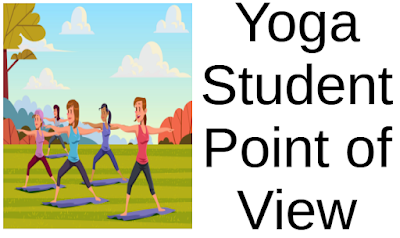For many people, the main concern in a yoga class is whether their legs are aligned correctly or whether they should be inhaling or exhaling as they fold forward. But for others, they wonder if they are betraying their religion or unintentionally participating in some kind of worship.
Is yoga a religion? Yes? No? It depends …
Is yoga a religion? Yes? No? It depends …
Religious institutions and organizations make determinations on spiritual matters related to their faith and creed. Obviously, not all religions are in agreement on all issues. This is especially true about yoga!
- “The physical component of yoga … has the potential to become a stepping stone to spiritual disciplines of a decidedly non-biblical character... It entails the possibility of coming into contact with demonic deception, manipulation, and even possession.”1
- “Yoga.... complements the Christian faith. ”2
- “From our theological perspective, techniques of relaxation and/or exercise (mental as well as physical) are not, of course, problematic in and of themselves. But it is the religious aspects of a practice such as Yoga that raises concerns for Christians”3
- “To be clear, yoga is not a faith... Practicing yoga does not mean it must be to the exclusion of practicing Judaism, or vice versa.”4
- “Islam and yoga could be compatible — if the Sanskrit benedictions are left out, and women’s skin-tight yoga gear is traded for more conservative garments. Reformed … It will not contradict with Islamic religion.”5
“Is Yoga a Hindu Practice?”
The answer according to Hinduism Today: “Deeply rooted in Hindu scripture and belief, yoga is, and always was, a vital part of Hindu religion and culture... It is sometimes argued that yoga is not Hindu per se; only the roots are Hindu. The fact that yoga is pursued by many non-Hindus is irrelevant to its validity as a Hindu practice.
The answer according to Hinduism Today: “Deeply rooted in Hindu scripture and belief, yoga is, and always was, a vital part of Hindu religion and culture... It is sometimes argued that yoga is not Hindu per se; only the roots are Hindu. The fact that yoga is pursued by many non-Hindus is irrelevant to its validity as a Hindu practice.
- The roots of yoga, its scriptural origins, are Hindu.
- The stem of yoga, its practice, is Hindu;
- and the flower of yoga, mystical union with God, is Hindu.
- Yoga, in its full glory, is entirely Hindu.”6
Public Schools:
In Alabama, teaching yoga in public schools has been banned since 1993. In August 2019, legislation was proposed to eliminate the ban. The legislation failed.
Yoga, according to the State Department of Education, is a "Hindu philosophy and method of religious training in which eastern meditation and contemplation are joined with physical exercises, allegedly to facilitate the development of body, mind, spirit." 7
Meanwhile …
In Encinitas, California, the parents of two public school students sued on grounds that the school-based yoga program for children promoted Hinduism.
The 4th District Court of Appeal disagreed. Judge John Meyer acknowledged that yoga “at its roots is religious” but added that the modern practice of yoga, despite its origins in Hindu philosophy, is deeply ingrained in secular American society and "is a distinctly American cultural phenomenon ... Whether an activity is religious for Establishment Clause purposes depends not on its religious roots, but upon the context in which the practice occurs. Yoga may be part of Hindu ritual and a religious practice in some contexts. Neither yoga booty ballet nor disco yoga likely occurs in such a context.”8 (Sedlock v. Baird)
Tax and Revenue Departments:
In New York, the Department of Tax and Finance exempted yoga studios from taxes. They concluded that, if the specific location offers only instruction in yoga, it is not a “weight control salon, health salon, or gymnasium” and, therefore, such an establishment is exempt from the tax.”9
“We looked into the history and origins of yoga and found that it was more meditative and spiritual rather than fitness," said Geoffrey Gloak, spokesman for the state Department of Taxation and Finance.10
Meanwhile …
In Washington, D. C., the Office of Tax and Revenue does NOT exempt yoga studios from taxes, they are considered fitness/health-club services.
Yoga Alliance, a nonprofit association representing over 7,000 Registered Yoga Schools and more than 100,000 Registered Yoga Teachers, argued that yoga studios should be exempt from taxes.
“Yoga is a comprehensive system for mental, emotional, spiritual, and physical well-being. It’s purpose is not physical exercise … it is spiritual rather than fitness … characterizing a Yoga business as a “health club” is inconsistent with Yoga teachings...misguided notions about the purpose of yoga become destructive when they lead to misplaced government burdens."11
And, just when you thought Yoga Alliance’s answer was “it is spiritual” …
They took the opposite view when it filing an amicus brief in support of the Encinitas, California public school yoga case (mentioned previously).
In the Encinitas brief, Yoga Alliance argued, “The modern practice of yoga typically comprises a physical system of exercises coupled with breath work and mindfulness practices, without any formal linkage to either Hindu or Buddhist worship… Although their Sanskrit names may be foreign, many yoga poses are similar to stretching or exercise positions seen outside of yoga (including football warm-ups).”12 … so … it’s “exercise?!”
In Alabama, teaching yoga in public schools has been banned since 1993. In August 2019, legislation was proposed to eliminate the ban. The legislation failed.
Yoga, according to the State Department of Education, is a "Hindu philosophy and method of religious training in which eastern meditation and contemplation are joined with physical exercises, allegedly to facilitate the development of body, mind, spirit." 7
Meanwhile …
In Encinitas, California, the parents of two public school students sued on grounds that the school-based yoga program for children promoted Hinduism.
The 4th District Court of Appeal disagreed. Judge John Meyer acknowledged that yoga “at its roots is religious” but added that the modern practice of yoga, despite its origins in Hindu philosophy, is deeply ingrained in secular American society and "is a distinctly American cultural phenomenon ... Whether an activity is religious for Establishment Clause purposes depends not on its religious roots, but upon the context in which the practice occurs. Yoga may be part of Hindu ritual and a religious practice in some contexts. Neither yoga booty ballet nor disco yoga likely occurs in such a context.”8 (Sedlock v. Baird)
Tax and Revenue Departments:
In New York, the Department of Tax and Finance exempted yoga studios from taxes. They concluded that, if the specific location offers only instruction in yoga, it is not a “weight control salon, health salon, or gymnasium” and, therefore, such an establishment is exempt from the tax.”9
“We looked into the history and origins of yoga and found that it was more meditative and spiritual rather than fitness," said Geoffrey Gloak, spokesman for the state Department of Taxation and Finance.10
Meanwhile …
In Washington, D. C., the Office of Tax and Revenue does NOT exempt yoga studios from taxes, they are considered fitness/health-club services.
Yoga Alliance, a nonprofit association representing over 7,000 Registered Yoga Schools and more than 100,000 Registered Yoga Teachers, argued that yoga studios should be exempt from taxes.
“Yoga is a comprehensive system for mental, emotional, spiritual, and physical well-being. It’s purpose is not physical exercise … it is spiritual rather than fitness … characterizing a Yoga business as a “health club” is inconsistent with Yoga teachings...misguided notions about the purpose of yoga become destructive when they lead to misplaced government burdens."11
And, just when you thought Yoga Alliance’s answer was “it is spiritual” …
They took the opposite view when it filing an amicus brief in support of the Encinitas, California public school yoga case (mentioned previously).
In the Encinitas brief, Yoga Alliance argued, “The modern practice of yoga typically comprises a physical system of exercises coupled with breath work and mindfulness practices, without any formal linkage to either Hindu or Buddhist worship… Although their Sanskrit names may be foreign, many yoga poses are similar to stretching or exercise positions seen outside of yoga (including football warm-ups).”12 … so … it’s “exercise?!”
The majority of Pew Research Center survey respondents did not believe yoga was a spiritual practice.
This finding was supported by The 2016 Yoga in America Study which found that the top five reasons for starting yoga are:
However ...
Another study found that:
This finding was supported by The 2016 Yoga in America Study which found that the top five reasons for starting yoga are:
- flexibility (61%);
- stress relief (56 %);
- general fitness (49 %);
- improve overall health (49 %)
- and physical fitness (44 %).
However ...
Another study found that:
- “Over 62 percent of students and 85 percent of teachers reported having changed their primary reason for practicing (yoga) ... for both, the top changed primary reason was spirituality.
- Findings suggest that most initiate yoga practice for exercise and stress relief, but for many, spirituality becomes their primary reason for maintaining practice.”13
Given yoga’s history, it is not surprising that many Americans answer, “Yes, yoga is a religion.”
- Yoga was derived from ancient Indian spiritual practices and texts.
- Yoga’s foundational literature focuses on spiritual development. For example, Patanjali’s second-century Yoga Sutra mentions no poses at all, other than seated meditation. The focus is on the “eightfold path” – guidelines for a meaningful, purposeful life and instruction on ethical conduct and self-discipline.
- Chanting (OM), mantras, mudras, mandalas, Sanskrit names for poses and “namaste” greetings are traditional practices of various religious and spiritual paths. Many yoga teachers include one or more of these practices in their classes.
But when we look at how yoga is practiced today in America, it is not surprising that that many people answer, “No, yoga is not a religion.”
- Although Western yoga has its historical roots in Hinduism, Jainism, and Buddhism, it’s not in itself a religion because it has no formal creed or set of rituals or obligations.
- The poses that we are familiar with today were not the main component of historical yoga. “Much of the yoga that dominates America and Europe today has changed almost beyond recognition from the medieval practices. The philosophical and esoteric frameworks … have been sidelined in favor of gymnastic movement, health and fitness.” 14
- Western yoga is a highly commercialized, social activity with studio memberships and pricey attire. Americans spend $16 billion per year on classes, yoga clothes and equipment. Personal interest, friends and free classes draw new students into studios.
- Then there are the thousands of clinical studies proving the efficacy of yoga for a variety of physical health conditions – from cancer to stress.
If I ... press my palms together, fingers pointing upwards, thumbs close to my chest does that mean I'm stimulating my anahata chakra - or am I just stretching my wrists?
If I ...kneel, rest my belly on my thighs, forehead on the floor does that mean I’m praying – or am I just stretching my back, hips, thighs, and ankles?
Is yoga fundamentally a religious activity? It can be... or not!
The
answer depends on you - your reason for practicing yoga and how you decide to practice!
ENDNOTES:
1. https://media.focusonthefamily.com/topicinfo/position_statement-yoga.pdf
2. https://www.crosswalk.com/church/worship/should-church-buildings-be-used-for-yoga-classes.html
3. https://www.lcms.org/about/beliefs/faqs/lcms-views#yoga
4. https://jewishyoganetwork.org/yoga-and-judaism/
5. https://www.nytimes.com/2012/04/09/nyregion/in-queens-seeking-to-clear-a-path-between-yoga-and-islam.html?_r=2&pagewanted=1
6. https://www.hinduismtoday.com/modules/smartsection/item.php?itemid=5673
7. https://www.al.com/news/2019/08/yoga-remains-prohibited-in-alabama-schools.html
8. https://yogaencinitasstudents.files.wordpress.com/2014/09/yesyogarb.pdf
9. https://www.tax.ny.gov/pdf/guidances/sales/g12_1s.pdf
10. https://www.dnainfo.com/new-york/20120726/new-york-city/yoga-exempt-from-sales-tax-because-its-not-exercise-state-rules/
11. https://www.yogaalliance.org/Portals/0/Articles/YA-Comment-Letter_DC-Budget-Health-Club-Tax.pdf
12. https://www.yogaalliance.org/Portals/0/Articles/Sedlock%20v.%20Baird%20Amicus%20Brief.pdf
13. https://pubmed.ncbi.nlm.nih.gov/25030795/
14. https://www.yogajournal.com/philosophy/yoga-s-greater-truth/











No comments:
Post a Comment